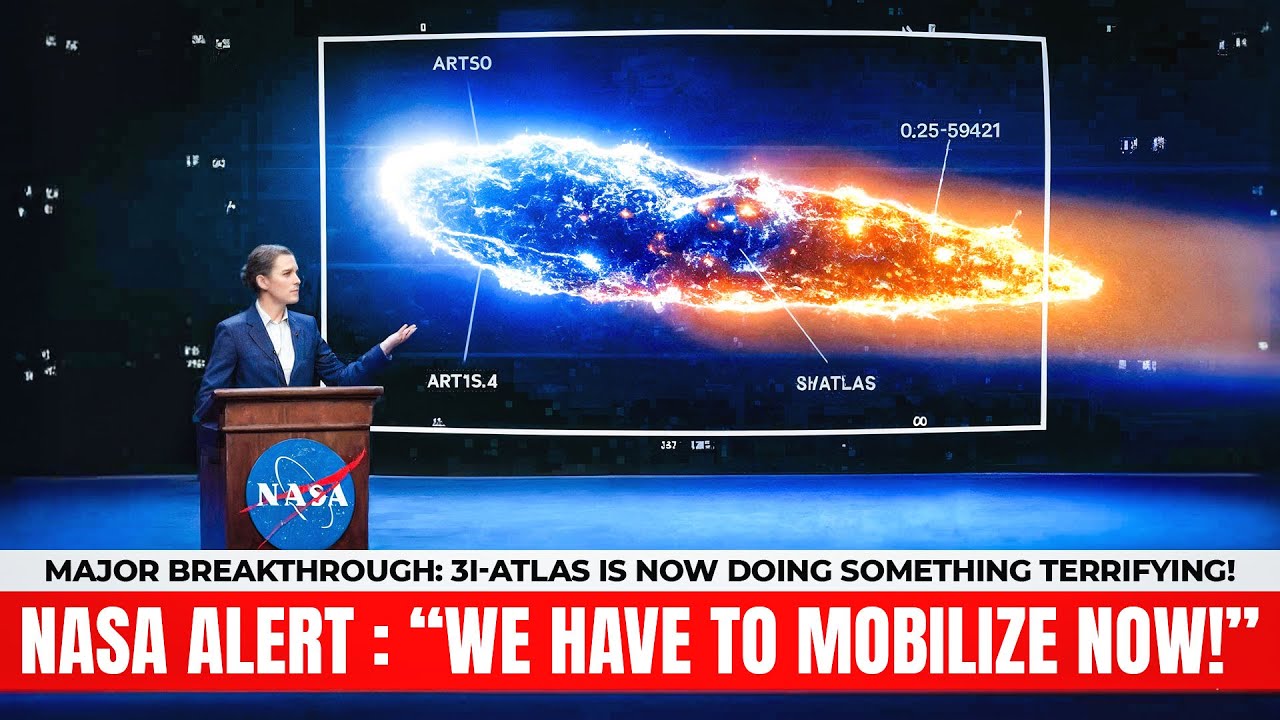In a development that has both astronomers and skywatchers around the world on edge, Comet 3I/ATLAS — a rare interstellar visitor — is exhibiting behavior unlike anything ever documented before. According to multiple observatories, the object is currently twisting its trajectory while emitting eerie, shifting colors that defy conventional explanation. As it races past Mars, experts are warning the public and the scientific community to “expect the unexpected.”
This is not just another passing comet. 3I/ATLAS is only the third known interstellar object to enter our solar system, following in the footsteps of 1I/‘Oumuamua in 2017 and 2I/Borisov in 2019. But what’s happening now is unprecedented — and scientists are scrambling to understand it.
An Interstellar Visitor Unlike Any Other
Discovered in early 2025 by the ATLAS survey telescope in Hawaii, 3I/ATLAS was initially thought to follow a predictable hyperbolic trajectory through our solar system. Its path would bring it closest to Mars in early October before slingshotting past the Sun and continuing its journey back into interstellar space.
However, in the last 72 hours, astronomers have noticed something strange. The comet’s projected course has begun to twist, deviating slightly from earlier models. At the same time, deep-space imaging revealed unusual light emissions: flashes of blue-green, crimson, and ultraviolet streaking across its coma, forming patterns never seen in natural bodies of this kind.
“We’ve monitored hundreds of comets and interstellar objects, but 3I/ATLAS is doing things that don’t match any known physical model,” said Dr. Elena Ruiz, an astrophysicist at the European Southern Observatory. “It’s as if the object is responding to forces we don’t yet understand.”
Flashing Lights and Twisting Paths
The comet’s strange light show has been confirmed by both ground-based telescopes and orbital instruments, including NASA’s MAVEN spacecraft orbiting Mars. Spectral analysis reveals the emissions do not correspond to typical cometary gases like cyanogen, water vapor, or carbon compounds. Instead, the light signatures shift in unpredictable ways — almost like a coded signal.
Simultaneously, its trajectory has shifted by a measurable fraction of a degree — not enough to pose an immediate threat to Earth, but enough to shock experts. These subtle deviations suggest that either external forces are acting on the comet, or its internal structure is producing thrust in ways we have not encountered before.
“It’s as though the comet has a mind of its own,” joked Dr. Raj Patel of the Indian Institute of Space Science. “Of course, that’s not literally true — but something is clearly happening beneath the surface.”
Theories Abound: From Natural Phenomena to Cosmic Mysteries
Scientists have put forward several working theories to explain this bizarre behavior:
-
Jetting from Asymmetric Ice Sublimation:
Some comets experience uneven sublimation — when ices on one side vaporize faster than the other, creating thrust that alters their path. However, the light emissions from 3I/ATLAS don’t match typical sublimation patterns. -
Electromagnetic Interaction:
Given its interstellar origin, 3I/ATLAS may carry unusual magnetic properties, causing unexpected interactions with the solar wind or Mars’ weak magnetic field. -
Fragmentation or Structural Instability:
The twisting path could be due to a partial breakup of the comet’s nucleus, causing pieces to exert uneven forces. -
Unknown Interstellar Material:
Some researchers speculate that the comet could contain material not found in our solar system, leading to chemical reactions that produce new forms of light. -
Speculative / Fringe Ideas:
As with ‘Oumuamua, some theorists have floated the possibility that 3I/ATLAS could be an artificial object — perhaps a fragment of alien technology or a defunct interstellar probe. There’s no evidence supporting this yet, but the unusual behavior is sure to fuel public imagination.
Why the Mars Flyby Matters
The timing and location of these anomalies are especially intriguing because they are happening as the comet passes near Mars. Several spacecraft — including NASA’s MAVEN, ESA’s Trace Gas Orbiter, and China’s Tianwen-1 orbiter — are positioned perfectly to capture high-resolution data.
This gives scientists an unprecedented opportunity to study 3I/ATLAS up close, in real time, as it performs what some have called “cosmic acrobatics.”
“This is a once-in-a-generation event,” said Dr. Ruiz. “We’re looking at an interstellar object that may challenge the very models we use to understand cometary behavior.”
Public Fascination and Viral Buzz
As images and videos of the flashing comet spread online, public curiosity has skyrocketed. Hashtags like #3IATLAS, #InterstellarMystery, and #CosmicTwist are trending across social media platforms. Amateur astronomers have begun livestreaming the object’s passage, and forums are ablaze with speculation — ranging from plasma discharges to alien probes.
Some viewers have described the shifting lights as “hypnotic,” while others find them “terrifying,” comparing the phenomenon to science-fiction scenarios.
No Threat to Earth — For Now
Space agencies have emphasized that, despite the trajectory changes, 3I/ATLAS poses no immediate danger to our planet. Its closest approach to Earth will still be millions of kilometers away. However, the unexpected deviations serve as a reminder that even well-modeled cosmic objects can surprise us.
What Happens Next
Over the coming weeks, astronomers will continue to monitor the object as it moves deeper into the inner solar system. New data from Mars orbiters and ground-based telescopes are expected to shed more light on the source of its mysterious behavior.
If the anomalies persist, 3I/ATLAS could rewrite aspects of our understanding of comet physics — or even reveal something entirely new.

